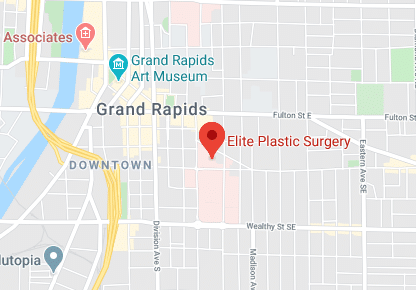Many of life’s changes can cause unwanted excess skin and fat in the lower portion of your body. A surgical thigh lift, or thighplasty, can help with sagging in the inner and outer thighs and give you a more pleasing body contour.
At Elite Plastic Surgery in Grand Rapids, Michigan, our board-certified plastic surgeons bring years of experience to every procedure. Our team can help you love how your legs look and feel.
Types of Thighplasty Procedures

Thigh lift surgery is also referred to as thighplasty. This procedure may involve one of several techniques: inner (medial) thigh lift, outer thigh lift, mini thigh lift, and thigh lift with liposuction.
Regardless of technique, the objective is to improve the appearance of the thighs and refine the contours of the inner or outer legs. We aim to bring this area into better proportion with the rest of your frame.
Types of Thighplasty Procedures
Excess skin on the thighs can cause both physical and cosmetic concerns. It can make movement uncomfortable, lead to chafing, and make clothing fit poorly.
You may want to get a thigh lift to experience benefits like:
- Smoother, firmer thighs
- Less skin rubbing and chafing
- Easier movement and physical activity
- Better-fitting pants, shorts, and other clothing items
- Improved balance between your thighs and the rest of your body
- More confidence in how you look
Types of Thighplasty Procedures
A thigh lift may be a good option for someone struggling with excess skin and fatty deposits in the thighs that are resistant to diet and exercise.
Ideal candidates for a thigh lift:
- Are at a healthy, stable weight
- Do not have medical conditions that could impair healing or increase infection risk
- Are non-smokers or willing to quit before surgery
- Have realistic expectations for the procedure’s outcome
- Are committed to maintaining results with a healthy lifestyle
If you’re feeling discouraged about your lower body, a thigh lift may be worth exploring.
Types of Thighplasty Procedures
There are several types of thigh lifts, each designed to target specific areas. During your consultation, your plastic surgeon will determine which procedure would be best for you.
Inner and Medial Thigh Lift
An inner thigh lift removes excess skin and tissue along the inner thigh. Incisions are typically placed in the groin area and may extend downward along the inseam to the knee, depending on how much skin needs to be removed.
A medial thigh lift targets the entire upper portion of the inner thigh. It typically involves a longer incision hidden in the groin crease, allowing the surgeon to lift and tighten a larger area of skin. This option is ideal for patients who want to improve the appearance of the inner thighs but do not require the extensive correction of a full inner thigh lift.
Mini Thigh Lift
A mini thigh lift is a less invasive procedure that treats localized sagging in the upper inner thigh. It uses a smaller incision within the groin crease and focuses on tightening a smaller area of skin. This technique is best for individuals with minimal sagging who want a subtle improvement in skin firmness.
Outer Thigh Lift
An outer thigh lift typically involves incisions that start in the groin and extend around the hip, sometimes going across the lower back. Our surgeons use advanced techniques to place the incisions in more discreet areas, so they’re less visible under most clothing and swimwear.
Thigh Lift With Liposuction
In some cases, we can combine a thigh lift with liposuction to give you more refined results. Liposuction removes stubborn pockets of fat, while the thigh lift addresses the excess skin and tissue.
What to Expect From Thigh Lift Surgery

For an inner thigh lift, the surgery is usually done as an outpatient procedure, so you can go home the same day.
An outer thigh lift is a bit more involved and may require an overnight stay in the hospital.
The surgical team will place you in the correct position for the procedure, and make the incisions carefully made based on the technique being used.
Once the surgery is complete, your incisions will be dressed, and compression garments may be applied to reduce swelling. Internal sutures will help support the newly contoured shape, while external sutures or other closing methods will secure the incisions as they heal.
Before you leave, your surgeon will go over immediate post-op care, pain management, and what to expect during the first few days of recovery. Be prepared to have someone who can take you home and assist you.
Recovery After Thigh Lift Surgery
After your thigh lift, you can expect some swelling, bruising, and mild discomfort, which is normal after surgery.
You’ll need to rest and avoid strenuous activities during the first few weeks. We encourage short, light walks to improve circulation and reduce the risk of blood clots.
We’ll also schedule follow-up appointments to monitor your progress, remove any external sutures if needed, and address any concerns.
Results After a Thighplasty
Factors that affect how long your results last include natural aging and weight management. With good habits, you can maintain your muscle tone and skin smoothness many years, even indefinitely.
However, you can expect tissue laxity to change over time as your body ages. This is natural and can be addressed with follow-up procedures or nonsurgical contouring techniques.
Risks of Thigh Surgery
Your surgeon will discuss the possible risks associated with treatment with you. Thigh lifts are very safe, but possible risks may include:
- Reactions to anesthesia
- Poor healing
- Bleeding
- Infections
- Fluid accumulation (seroma)
- General persistent pain
- Swelling
- Unwanted scarring
- Numbness in the treated area
Our board-certified team is skilled and will take every precaution to mitigate these risks.
Why Choose Elite Plastic Surgery?
At Elite Plastic Surgery in Grand Rapids, our board-certified plastic surgeons – Dr. Shannon Armstrong, Dr. William Cullen, Dr. Matthew Martin, and Dr. Matthew Fahrenkopf – bring over 40 years of combined experience and advanced training to every procedure. With expertise in body contouring, breast surgery, hand and wrist surgery, and microsurgery, our team uses the latest techniques to deliver natural, lasting results. Each surgeon has trained at renowned institutions, contributes to ongoing research, and shares their knowledge by teaching the next generation of surgeons.
We focus on clear communication and patient education so you feel informed throughout the process. Our surgeons combine precision, advanced skills, and thoughtful care to get results that make you look and feel incredible.
FAQ
How Is a Thigh Lift Different From Liposuction?
Liposuction focuses on the removal of stubborn fat cells. A thigh lift repositions the tissue of this area of the body so the skin lies more smoothly across muscle and fatty tissue. The lift procedure is conducted to refine the shape of your thighs by removing sagging superficial tissue. Because of their differences, liposuction and thighplasty are quite complementary.
How Long Should I Wait After a Thigh Lift to Exercise?
Every patient has their own unique healing process. Generally speaking, you may resume light activity approximately two weeks after thighplasty. However, each patient will need to receive clearance from their surgeon before resuming an exercise routine.
Initially, light activities may be limited to walking and other light activities such as light crunches, wall push-ups, and light dumbbell exercises. You should start to gradually increase your level of exercise over time. You can potentially get back to strenuous activities after approximately six weeks, but approach with caution and pay close attention to any pain and fatigue.
Will I Have Noticeable Scarring After a Thigh Lift?
Scarring is a common concern after any surgical procedure. The thigh lift is performed with an awareness of scars and their location. We make incisions in discreet locations as much as possible.
For example, we conduct the inner thigh lift through incisions that sit within the crease of the groin (the bikini line). A medial thigh lift will include this incision as well as one that runs down the inner thigh to the knee.
Resulting scars typically fade away over time to a point at which they are barely perceptible.
Do You Lose Weight With a Thigh Lift Procedure?
It is possible to see a small amount of weight reduction after a thigh lift. This is due to the removal of excess skin and fat. However, a thigh lift is not a weight loss solution, so it is best to be close to your ideal weight before having the procedure performed. It is meant to improve both the contour and shape of your thigh.
How Long Does a Thigh Lift Last?
On average, the results from a thigh lift can last around five to 10 years. However, the longevity of these results depends on several factors:
- You should eat a healthy diet that helps you maintain your current weight.
- Avoid alcohol and stop smoking if you are a smoker.
- When cleared medically, you can resume your regular exercise routine to tone your muscles and maintain your weight.
How Do I Prepare for a Thigh Lift?
Before the procedure can begin, the plastic surgeon will require you to make a few preparations:
- You might have to get a medical evaluation. This is done to ensure you are in good health and that you do not have any underlying conditions that could interfere with the procedure.
- If you are a smoker, you will have to quit for a while.
- Depending on the medication you take, you might have to stop taking them or have them adjusted by your doctor.
- You also have to refrain from taking medication such as aspirin, herbal supplements, and anti-inflammatories, as these could increase the risk of bleeding.
- Arrange for someone to drive you home and assist you during the first few days.
- Set up a comfortable recovery area with essentials like pillows, loose clothing, and easy-to-reach items.
- Stock up on any prescribed medications, dressings, and healthy, simple meals.
What Are the Contraindications to a Thigh Lift Procedure?
Certain medical conditions or lifestyle factors may make a thigh lift unsafe or unsuitable, including:
- Uncontrolled or poorly managed chronic conditions (e.g., diabetes, heart disease)
- Blood clotting disorders or history of deep vein thrombosis (DVT)
- Active infections or untreated medical issues
- Smoking, unless you are able to quit for a specified period before and after surgery
- Significant weight fluctuations or plans for major weight loss
- Poor wound healing history or a weakened immune system
- Unrealistic expectations for the procedure’s results
If any of these apply, your surgeon will discuss alternative options or the steps necessary to improve your eligibility for a thigh lift.
Click Here To View Our Post-Op Instructions
How Long Does It Take to Recover From a Thigh Lift?
Recovery time varies for each patient, but most people can resume light activities within two weeks. Strenuous exercise and heavy lifting should be avoided for about six weeks or until cleared by your surgeon. Swelling and bruising will gradually subside over the first few weeks.
Can a Thigh Lift Be Combined With Other Body Contouring Procedures?
Yes, a thigh lift can be combined with procedures like liposuction, tummy tucks, or other body contouring surgeries. Combining treatments can address multiple areas at once, providing more balanced results.
How Soon After Weight Loss Can I Have a Thigh Lift?
It is best to wait until you have reached a stable weight that you can maintain. Significant weight fluctuations after surgery can affect your results. Generally, patients should wait at least six months to a year after major weight loss to allow their weight and skin to stabilize.
When Can I Return to Work After a Thigh Lift?
Most patients can return to light, desk-based work within one to two weeks. If your job requires physical activity, you may need to wait longer – typically about four to six weeks. Your surgeon will provide guidance based on your specific healing progress.
What Financing Options Are Available?
Thigh lift surgery is typically not covered by insurance as it is considered a cosmetic procedure. For payment flexibility, we accept financing through CareCredit and Prosper HealthCare Lending, both of which offer convenient monthly payment plans. CareCredit allows you to apply easily online and receive an immediate decision, while Prosper HealthCare Lending provides trusted financing solutions with competitive terms.
Schedule a Consultation for Your Thigh Lift in MI or Call for Questions
If you’re considering a thigh lift, call our Grand Rapids office today! Our board-certified plastic surgeons are here to answer your questions and help you explore the best options.
Call 616-459-1907 to schedule a consultation with one of our plastic surgeons.

